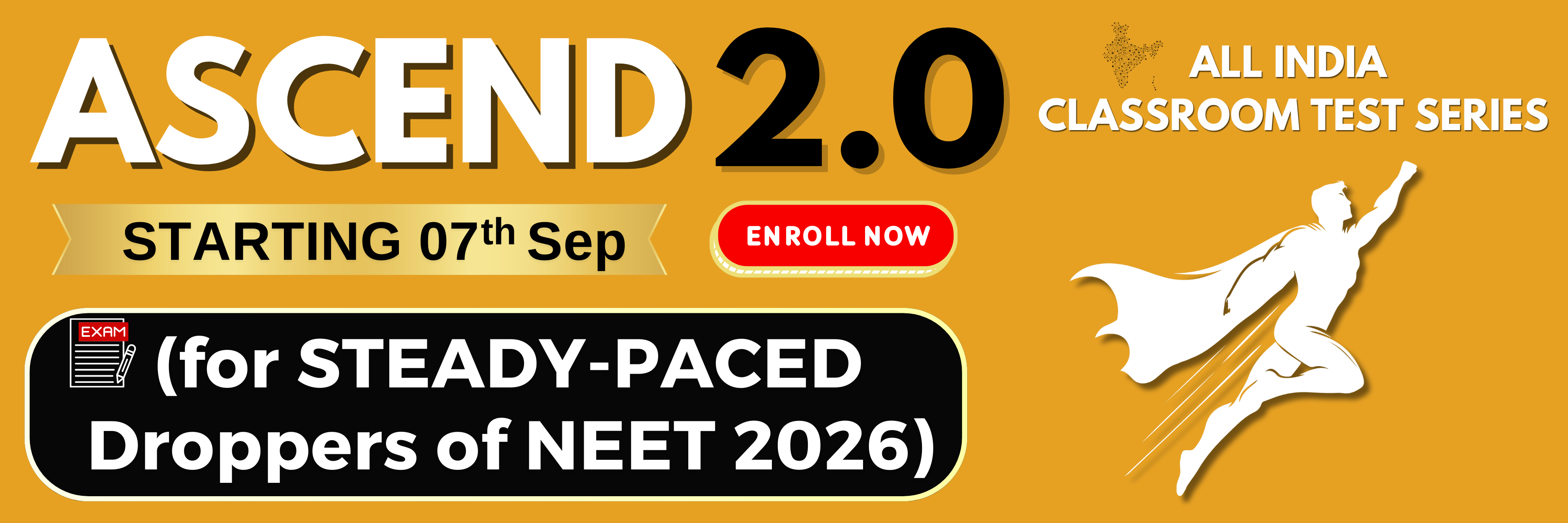Given below are two statements: one is labelled as Assertion (A) and the other is labelled as Reason (R).
In the light of the above statements, choose the correct answer from the options given below :
| Assertion (A): | All vertebrates are chordates but all chordates are not vertebrate. |
| Reason (R): | The members of subphylum vertebrata possess notochord during the embryonic period, the notochord is replaced by a cartilaginous or bony vertebral column in adults. |
| 1. | (A) is True but (R) is False. |
| 2. | (A) is False but (R) is True. |
| 3. | Both (A) and (R) are True and (R) is the correct explanation of (A). |
| 4. | Both (A) and (R) are True but (R) is not the correct explanation of (A) |
Subtopic: Phylum Chordata |
68%
Level 2: 60%+
NEET - 2025
Please attempt this question first.
Hints
Please attempt this question first.
Match List I with List II:
Choose the correct answer from the options given below:
1. A-II, B-I, C-IV, D-III
2. A-II, B-IV, C-I, D-III
3. A-IV, B-III, C-II, D-I
4. A-IV, B-II, C-III, D-I
| List I | List II | ||
| A. | Pleurobrachia | I. | Mollusca |
| B. | Radula | II. | Ctenophora |
| C. | Stomochord | III. | Osteichthyes |
| D. | Air bladder | IV. | Hemichordata |
Choose the correct answer from the options given below:
1. A-II, B-I, C-IV, D-III
2. A-II, B-IV, C-I, D-III
3. A-IV, B-III, C-II, D-I
4. A-IV, B-II, C-III, D-I
Subtopic: Phylum Ctenophora | Phylum Mollusca | Phylum Hemichordata | Phylum Chordata |
85%
Level 1: 80%+
NEET - 2024
To view explanation, please take trial in the course.
NEET 2026 - Target Batch - Vital
Hints
To view explanation, please take trial in the course.
NEET 2026 - Target Batch - Vital
Match List I with List II:
Choose the correct answer from the options given below:
| List I | List II | ||
| A. | Pterophyllum | I. | Hag fish |
| B. | Myxine | II. | Saw fish |
| C. | Pristis | III. | Angel fish |
| D. | Exocoetus | IV. | Flying fish |
Choose the correct answer from the options given below:
| 1. | A-III, B-I, C-II, D-IV |
| 2. | A-IV, B-I, C-II, D-III |
| 3. | A-III, B-II, C-I, D-IV |
| 4. | A-II, B-I, C-III, D-IV |
Subtopic: Phylum Chordata |
71%
Level 2: 60%+
NEET - 2024
To view explanation, please take trial in the course.
NEET 2026 - Target Batch - Vital
Hints
To view explanation, please take trial in the course.
NEET 2026 - Target Batch - Vital
The following are the statements about non-chordates:
Choose the most appropriate answer from the options given below:
| A. | Pharynx is perforated by gill slits. |
| B. | Notochord is absent. |
| C. | Central nervous system is dorsal. |
| D. | Heart is dorsal if present. |
| E. | Post anal tail is absent. |
Choose the most appropriate answer from the options given below:
| 1. | A, B & D only |
| 2. | B, D & E only |
| 3. | B, C & D only |
| 4. | A & C only |
Subtopic: Phylum Chordata |
66%
Level 2: 60%+
NEET - 2024
To view explanation, please take trial in the course.
NEET 2026 - Target Batch - Vital
Hints
To view explanation, please take trial in the course.
NEET 2026 - Target Batch - Vital
Match List-I with List-II:
Choose the correct answer from the options given below:
| List-I | List-II | ||
| A. | Chondrichthyes | I. | Clarias |
| B. | Cyclostomata | II. | Carcharodon |
| C. | Osteichthyes | III. | Myxine |
| D. | Amphibia | IV. | Ichthyophis |
Choose the correct answer from the options given below:
| 1. | A-II,B-IV,C-I,D-III |
| 2. | A-I,B-III,C-II,D-IV |
| 3. | A-II,B-III,C-I,D-IV |
| 4. | A-I,B-II,C-III,D-IV |
Subtopic: Phylum Chordata | Comparative study of Cartilagenous & Bony Fishes | Study of Amphibians | Class Chondrichthyes |
78%
Level 2: 60%+
NEET - 2024
To view explanation, please take trial in the course.
NEET 2026 - Target Batch - Vital
Hints
To view explanation, please take trial in the course.
NEET 2026 - Target Batch - Vital
Given below are two statements: One is labelled as Assertion A and the other is labelled as Reason R.
In the light of the above statements, choose the correct answer from the options given below:
| Assertion (A): | Members of subphylum vertebrate possess notochord during the embryonic period. The notochord is replaced by a cartilaginous or bony vertebral column in the adult. |
| Reason (R): | All chordates are vertebrates but not all vertebrates are chordates |
| 1. | (A) is True but (R) is False |
| 2. | (A) is False but (R) is True |
| 3. | Both (A) and (R) are True and (R) is the correct explanation of (A). |
| 4. | Both (A) and (R) are True but (R) is not the correct explanation of (A). |
Subtopic: Phylum Chordata |
70%
Level 2: 60%+
NEET - 2024
To view explanation, please take trial in the course.
NEET 2026 - Target Batch - Vital
Hints
To view explanation, please take trial in the course.
NEET 2026 - Target Batch - Vital
Select the correct statements with reference to chordates.
Choose the correct answer from the options given below:
| A: | Presence of a mid-dorsal, solid and double nerve cord. |
| B: | Presence of closed circulatory system. |
| C: | Presence of paired pharyngeal gill slits |
| D: | Presence of dorsal heart. |
| E: | Triploblastic pseudocoelomate animals. |
| 1. | C, D and E only | 2. | A, C and D only |
| 3. | B and C only | 4. | B, D and E only |
Subtopic: Phylum Chordata |
82%
Level 1: 80%+
NEET - 2023
To view explanation, please take trial in the course.
NEET 2026 - Target Batch - Vital
Hints
To view explanation, please take trial in the course.
NEET 2026 - Target Batch - Vital
Given below are two statements : one is labelled as Assertion (A) and the other is labelled as Reason (R)
In the light of the above statements, choose the most appropriate answer from the options given below:
| Assertion (A): | All vertebrates are chordates but all chordates are not vertebrates. |
| Reason (R): | Notochord is replaced by vertebral column in the adult vertebrates. |
| 1. | (A) is False but (R) is True. |
| 2. | Both (A) and (R) are True and (R) correctly explains (A). |
| 3. | Both (A) and (R) are True and (R) does not correctly explain (A). |
| 4. | (A) is True but (R) is False. |
Subtopic: Phylum Chordata |
74%
Level 2: 60%+
NEET - 2022
To view explanation, please take trial in the course.
NEET 2026 - Target Batch - Vital
Hints
To view explanation, please take trial in the course.
NEET 2026 - Target Batch - Vital
Which one of the following features are not true for chordates?
(a) Heart is dorsal.
(b) Pharynx is perforated by gill slits.
(c) Central nervous system is ventral, solid and single.
(d) Post-anal tail is present.
(e) Notochord is present.
Choose the most appropriate answer from the option given below:
| 1. | (e) only | 2. | (a), (d) and (c) only |
| 3. | (b) and (c) only | 4. | (a) and (c) only |
Subtopic: Phylum Chordata | Comparative study of Cartilagenous & Bony Fishes |
73%
Level 2: 60%+
NEET - 2022
To view explanation, please take trial in the course.
NEET 2026 - Target Batch - Vital
Hints
To view explanation, please take trial in the course.
NEET 2026 - Target Batch - Vital
Which of the following statements are true for the phylum-Chordata?
| (a) | In Urochordata, notochord extends from head to tail and is present throughout their life |
| (b) | In Vertebrata, notochord is present during the embryonic period only |
| (c) | Central nervous system is dorsal and hollow |
| (d) | Chordata is divided into 3 sub-phyla : Hemichordata, Tunicata and Cephalochordata |
1. (c) and (a)
2. (a) and (b)
3. (b) and (c)
4. (d) and (c)
Subtopic: Phylum Chordata |
69%
Level 2: 60%+
NEET - 2020
To view explanation, please take trial in the course.
NEET 2026 - Target Batch - Vital
Hints
To view explanation, please take trial in the course.
NEET 2026 - Target Batch - Vital






